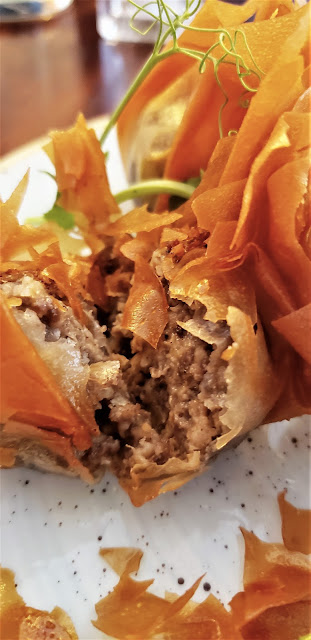The second leg of our Grand Tour this summer took us to Ireland, justifiably known as the Emerald Isle. It is here perhaps that I went the craziest taking pictures. Once back on dry land after crossing the Irish Sea, we settled in Waterford, established by Reginald the Viking in the early 900s, and famous since the 1700s for being home to the fine crystal that bears the city's name.
We stayed at the Tower Hotel, aptly named as it stands just about twenty feet from the short but impressive Reginald's Tower. Built sometime between the 13th and 14th centuries, it was used at different times as a mint, a prison, and a military storehouse.
Our first evening in Ireland was a foreshadowing of the fun this country has to offer. I don't think there are any unhappy Irishmen or Irishwomen. Everyone is in a perpetual party mood. For dinner at Hobson's, housed within the hotel, we sat at long tables that encourage sociability. Our end was populated by people from Michigan, New Jersey, and Georgia, all (except me) eagerly awaiting the spectacle at the end of the meal that is the preparation of an Irish Coffee.
For an appetizer, I tried the smoked salmon rolls with cream and roasted vegetables, a subtle and light start that stimulates your appetite for the heartier main course, a Guinness-glazed flat beef steak in the company of the ubiquitous Yorkshire pudding.
The next morning was a shopper's delight. We visited the iconic Waterford crystal factory to see magic in the making, how a block of icy glass turns into a masterpiece. And of course, they have a magnificent showroom where you can indulge in purchasing pieces that range from a votive candle holder (that's what I bought) to Cinderella's carriage carved in precise detail.
Feeling spoiled and sophisticated with my Waterford purchase, I was ready for our next stop at Kilkenny Castle. Built in the 1190s by Richard de Clare, 2nd Earl of Pembroke, nicknamed Strongbow, the castle was part of the town's fortification system. In the 15th century it belonged to the Butlers of Ormond, a powerful ruling family of which Lady Margaret Butler was a member. Lady Margaret was the wife of Sir William Boleyn and consequently the paternal grandmother of Anne Boleyn, second wife of King Henry VIII.


After indulging in a supersized eclair in the castle bakery, we said goodbye to bucolic Kilkenny and readied ourselves for some boisterous fun. Dublin is a bustling, happy city where people work hard and play harder. Our Hilton hotel was ten steps across from the Sean O'Casey Bridge, an ultra modern structure over the River Leiffy that provides opportunity for a lovely promenade to the south side of the quays, the shopping side, the nightlife side. My ultimate goal as I walked the lively streets was to find
The Temple Bar, established in the 1800s (although the building has been there since the 1600s) and perhaps the most iconic pub in Dublin. It takes up an entire corner and adorns the street with flower boxes that cascade down the building on all sides, it's painted black, lipstick red, and gold, and it's always busy, no matter the time of day. I wonder if it has something to do with the over 450 types of rare whiskey available, the largest collection in all of Ireland?

During our search for The Temple Bar, we stopped at Cloud Nine, a gelato joint that delighted with its outstanding performance of that elusive authentic creamy, flavorful quality that sets Italian ice cream so far apart from any other, at least for me.
Dublin provided one of the most entertaining evenings I've spent EVER. At Taylor's Irish Cabaret we were immersed into the Irish experience. The dining hall is an enormous medieval barn, thatched roof and all, with long tables, all strategically placed to get the best view of the stage. An award-winning group of Irish dancers enthrall with their skilled stepdance, and a trio of superb Irish musicians regale us with happy jigs and beloved Irish ballads that can uplift you, amuse you, or bring a tear to your eye. And all this while enjoying a dish of hearty Irish Stew and all the ale and whiskey you dare to consume.

On our way north in expectation of crossing the North Channel into Scotland, we stopped in Belfast, the capital of Northern Ireland, and known to most as the historical center of sectarian conflict between Catholics and Protestants. Although its past has been violent and polarizing at times, on this day we marveled at its stunning Victorian architecture represented by Belfast City Hall, a sprawling beauty that grew from the Old Town Hall when Queen Victoria awarded Belfast city status in the 19th century.
We said goodbye to lovely Ireland, land of saints and scholars, with wonderful memories of laughter and amazing sites. Next stop, Scotland!





























































































